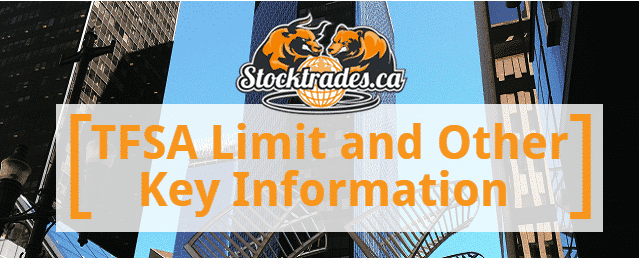TFSA Limit And Other Key TFSA Information For 2024
Most if not all view the government and more precisely the tax authorities as a malignant money sucking spirit that cares about one thing and one thing only – filling its own coffers.
Such a viewpoint comes under scrutiny when certain elements of the tax system are discussed. This article covers one of those, known as the Tax-Free Savings Account or the TFSA.
As an incentive for the public to save and invest, the TFSA came into effect on January 1st of 2009. This was following the global financial meltdown which occurred in the preceding year. At this present date, most financial institutions offer the option of opening a TFSA with them.
Who came up with the TFSA?
This program was the brainchild of the then Canadian federal minister of finance, Jim Flaherty, and had many proponents in the form of the Bank of Montreal, Canadian Bankers Association, Canadian Chamber of Commerce, Canadian Taxpayers Federation, and the Canadian Federation of Independent Business. According to the C.D. Howe Institute, one of Canada’s most formidable think tanks and trusted source of independent evidence-based research in policy intelligence and research, the program was a great step towards improving the welfare of Canadians.
Canada wasn’t the first country to implement a Tax free savings account

Based on the information stated in the previous paragraph, one may jump to the conclusion that Canada was the first country to formulate such an innovated public policy. However, that is not the case. The TFSA is very similar to the Individual Savings Accounts that have existed in the UK since 1999. There is also the Roth Individual Retirement Arrangement in the United States, which comes with more restrictions.
Recently, South Africa also introduced TFSA accounts. All this is non-mundane information because it shows that the TFSA policy is a tried and tested mechanism that is here to stay.
For those who have not already deciphered the purpose of the TFSA, it is a savings account wherein investments and gains (dividends, capital gains, and interest) are exempt from taxes. The best part? One can withdraw funds at any time. However, contributions made to the TFSA are not tax-deductible.
When it comes to eligibility, anyone above the age of 18 can contribute to a TFSA, irrespective of where they earned any income.
The TFSA limit for 2018 and beyond
Unfortunately, there are certain restrictions that come with the TFSA, including a TFSA limit of contributions. For 2018, your TFSA limit will be the same as that of the previous year i.e. a maximum of $5,500.
The exciting part is that this TFSA contribution room, if unused, tends to accumulate over the years. In other words, if you do not hit your maximum TFSA limit this year, the amount will carry over and will be added to your TFSA limit for the next year.
To better understand this concept, let’s assume that a person who was +18 years in 2009 has not yet contributed anything to the TFSA till date. For that person, the TFSA limit for all the years would be added, giving them a total TFSA limit of $57,500. The table below shows how we arrive at this number.
TFSA limit by year
[table id=18 /]
Also, the TFSA limits only what you can contribute, not the gains. However, the CRA does investigate certain accounts. Active traders who are involved in speculative products usually own most of the accounts under investigation. These accounts make up less than 1% of the total TFSA accounts.
Something that jumps out when one looks at the above table is the change to the TFSA limit over the years, especially the $10,000 in 2015.
Why not a $10,000 TFSA limit every year?
The $10,000 is an exception. This is because the Harper government at that time had almost doubled the amount. Unfortunately for TFSA contributors, the new government came into power in December 2015. They reversed the decision, bringing the TFSA limit back down to 2014 numbers.
The TFSA limit, however, will increase in the future as it is indexed for inflation. Unfortunately though, the limit increases in increments of $500 only. This is much like personal tax credits and tax brackets.
**The indexation adjustment for personal income tax and benefit amounts was 1.5% for 2018. This was not enough to raise the TFSA limit to the next $500 increment.**
Exceptions to the TFSA limit
There are certain cases when an individual may not accrue the complete TFSA limit for a taxation year. For instance, if the individual is not a resident of Canada throughout the entire year. Furthermore, the TFSA limit is not allotted for the year in which the individual dies or becomes a resident of Canada.
Another instance when the TFSA limit for the year will not be granted is when the individual does not file a tax return. But this case has an easy remedy. Just file a return for previous years by using a method acceptable by the CRA.
Finally, qualifying transfers, exempt contributions, and specified distributions are not included in the calculation of TFSA contribution room.
What Happens to my TFSA limit when I withdraw?
If you withdraw money from your TFSA, you get the limit back. But here is the tricky part. You do not regain this amount until the following calendar year. As a result, it makes sense to make withdrawals at the end of the year (preferably last week of December). This way you regain the room on your TFSA limit as soon as possible.
A simple formula and bit of number crunching can allow one to calculate their TFSA limits:
TFSA contribution room at the beginning of next year = Unused TFSA contribution room + withdrawals made in current year + following year’s TFSA dollar limit
What happens if I over-contribute?
Amounts more than the contribution limit for an individual are subject to 1% penalty charged monthly. If you exceeded your TFSA limit by $1000 for five months, the penalty would amount to $10,000 X 1% X 5 = $500. The rules have been clearly laid out. Yet over-contributions are more common than what one would assume. In 2012, the CRA reported 74,000 cases related to over-contributions. That number was a lot lower than that of 103,000 cases in 2010 when the TFSA was a new concept.
There are many reasons why people make mistakes. The most common is assuming that contribution is regained in the year in which an amount is withdrawn. Over the years, financial institutions have realized this. They would help you out by flagging your account if you over-contribute. But this mechanism would not work if you had TFSA with more than one financial institution. Individually, you would be within the limit for each of the banks. But, combined you might be over your total alloted limit.
In other cases, people just lose track of their TFSA contributions and withdrawals. A simple solution to this problem is to keep a log of all your current TFSA accounts. Keep note of withdrawals and contributions, or stick with 1 TFSA account to prevent any confusion.
Obtaining more information on your TFSA account
The CRA does a decent job when it comes to providing details on your unused contribution room, albeit, up to that of the preceding calendar year only. So, you have no option but to add the current year’s contribution yourself.
It’s fairly simple to receive information in a convenient and timely manner. Simply sign up for the online mailing system instead of receiving paper mail through Canada Post. The CRA will send you an e-mail notification whenever there is new information about your account.
But it can sometimes become difficult to understand the nitty-gritty when the notice of assessment and “explanation of changes and other important information” are presented separately.
Sign up for CRA’s My Account to receive up to date information
One way to overcome this problem is by accessing your account information on your account at CRA’s website. Apart from providing information on the TFSA, “My Account” also provides information on a person’s RRSP contribution room, GST/HST credits, edibility for Canada Child Benefits and much more.
To access the account, one would need their social insurance number, notice of assessment (mainly line 150 of previous year’s tax return which shows total income reported) and date of birth.
In case you want to save yourself from the nuances and agony that is associated with obtaining this information on your own accord, you many choose a representative to do the work for you. A representative can be your spouse or common-law partner, tax preparer, or accountant. In most cases, individuals assign these representatives to both provide and receive information on their behalf.
How to authorize a representative to manage your TFSA
You can authorize a representative through the My Account for individual accounts or by sending Form T1013 (Authorizing or Cancelling a Representative) to the CRA. The authorization stays in effect unless canceled by the taxpayer or the representative. It also expires when it reaches the expiry date chosen at the time of authorization. Or finally, the death of the taxpayer. Cancellation can be done over the phone, in person or in writing.
The last option is to talk to a CRA representative over the phone (and suffer long wait times). This is through a service known as Tax Information Phone Service (TIPS). The phone number for TIPS is 1-800-267-6999. If all fails, then the safest option to avoid any penalties is to just contribute the maximum amount allowed annually. For 2018, this is $5,500.
Wrong information sent to the CRA about your TFSA
You need to understand that it is the TFSA issuer’s prerogative to provide the CRA with information on your account. All issuers have until the last day of February to do so. They do this by electronically submitting a TFSA record to the CRA.
The important point that we are trying to arrive at is that there is a possibility that your issuer makes errors while submitting information on your behalf. Errors could arise on TFSA Room Statement, or TFSA Transaction Summary, such as dates, or amounts of contributions, or withdrawals. In such cases, you as a tax payer need to contact your TFSA issuer. Simply ask them to send the correct information to the CRA.
Who and what can be done with the TFSA account?
The TFSA holder can perform tasks such as making contributions, making withdrawals, and determining how funds are invested.
However, akin to how you can assign a representative to obtain information on the TFSA on your behalf, you can assign another person to make investments for you. This also means that you can use the TFSA account of another family member. This can be family members like your spouse or common-law-partner. This allows you to make investments above and beyond your contribution limit, by maximizing theirs.
**Note that if you assign an advisor to manage the TFSA account, the fees paid for such services do not form a part of the TFSA.**
What can you invest in in your TFSA?
As a rule of thumb, a TFSA can hold most assets that can be invested in an RRSP. Some of these assets include shares of public and private corporations, some debt obligations, foreign exchange investments, mutual funds, real-estate trusts, annuity contracts, warrants, rights and options, registered investments, partnership units, royalty units and depository receipts.
In case of foreign investments, two important points need to be kept in mind. First, the value of your foreign investments will be converted to the Canadian Dollars equivalent. This amount cannot exceed the available contribution room. It’s important to do conversions prior to investing!
Second, if the asset pays foreign dividends, you might be subject to a withholding tax – contrary to rules applicable to a non-registered account, where one receives foreign tax credits. In case of the US, exceptions apply to the RRSP and RRIF. One does not have to pay taxes on dividends received on stocks invested in those accounts. But unfortunately, the same does not hold true for the TFSA.
There are ways to avoid the withholding taxes in your TFSA
There is a way to get around the 15% withholding tax imposed by the IRS by investing in ETFs that use swap contracts. These mimic the return of underlying dividend-paying stocks in the fund without holding any of the stocks. But the caveat here is that fees charged by the counter-party to the swap agreement and the management fees tend to exceed the taxes that you would have had to pay to the US Government if you had invested in the stock directly.
Unfortunately, most Canadians are oblivious to these numerous options available. According to a report published by the Royal Bank of Canada, close to 44% of Canadians had their TFSAs invested in high-interest savings account. Another 21% chose guaranteed investment certificates as their preferred asset
It could also be that most Canadian investors do not have an appetite for high-risk investment. This fear and risk, however, can be eliminated with educated investments. Something we teach at Stocktrades.
TFSA vs RRSP
Whether to invest in an RRSP or TFSA is a common question among many. To arrive at a sensible answer to that question, it will be best to do a quick comparison of the benefits provided by these tools. If you want a complete in-depth guide of the pros and cons of each, check out our TFSA vs RRSP article.
An RRSP is used as an income tax reduction tool, or a tax-deference tool. You invest in the RRSP when your marginal tax rate is high. Then, wait until retirement to withdraw the funds, when the tax rate will be lower. This is assuming your income will be lower in retirement, which is more than likely the case. The TFSA, on the other hand, is not tax deductible. Also, in case of the RRSP, you need to withdraw your funds by the age of 71. This is not the case with the TFSA, as your account never expires.
For those who are earning a low income, it makes more sense to use the TFSA. Your income tax reduction via investing in the RRSP will be the same rate as when you take it out in your retirement years. In later years, when your marginal tax rate is higher a good strategy would be to invest in the RRSP and use the reductions to invest in the TFSA account.
For those south of the border

Canada and the US have an agreement where Canada is obligated to assist the IRS with the collection and reporting of information on U.S. persons living here in Canada in order to comply with the U.S. Foreign Account Tax Compliance Act.
This act creates complications when it comes to filing taxes, especially if Canadian citizens (who also hold a US passport) use accounts such as the Registered Education Savings Plan (RESP) and TFSA.
To be precise, the IRS does not treat the TFSA as a pension plan and considers mutual funds held in TFSAs to be investments in a passive foreign investment company (PFIC) which have to be reported on form 8621.
PFICs can cause a high tax bill because if certain restrictions are absent, excess distributions are taxed at the highest marginal tax rate which can be close to 50% or more. In other cases, the TFSA can be a grantor trust in the eyes of the IRS, implying that taxpayers need to fill forms IRS Forms 3520A (due March 15) and 3520 (due at the same time as Form 1040). These two forms are highly complicated and involve large penalties in the case of late filings.
Due to these complications and the potential for heavy taxes and penalties, it is best to avoid these investments if you are a dual citizen of the US and Canada.
Leaving a Pot of Gold in Your Backyard
TFSAs can be compared to those kids who were not that popular in high school but took to full blossom as soon as they entered college. When this program was first introduced, most people didn’t pay heed because you could invest only around $5000. However, given the cumulative nature of TFSAs, now many people have a limit close to $60,000 and $70,000. And if you are looking at a husband-wife pair or common-law-partners, then double this amount.
These high limits are especially useful for those who receive an inheritance or a sudden influx of cash. In fact, given the benefits associated with TFSA, not investing in them is akin to leaving a pot of gold in the backyard.

